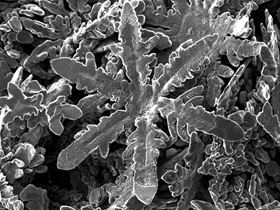Snowflakes show their metal


Scientists in New Zealand and Australia working at the level of atoms have created something unexpected – tiny metallic snowflakes. This is significant because coaxing individual atoms to cooperate in desired ways is leading to a revolution in engineering and technology via nanomaterials Such nanoscale structures could aid electronic manufacturing, make materials stronger yet lighter or aid environmental clean-ups by binding to toxins.
To create metallic nanocrystals, the team of New Zealand and Australian scientists had been experimenting with gallium, a soft, silvery metal that is used in semiconductors and, unusually, liquifies at just above room temperature. The team included Nicola Gaston and Steph Lambie, both of Waipapa Taumata Rau, University of Auckland, and Krista Steenbergen of Te Herenga Waka, Victoria University of Wellington, who collaborated with colleagues in Australia led by Kourosh Kalantar-Zadeh at the University of New South Wales. They report their results in a paper in Science.
The Australian team worked in the lab with nickel, copper, zinc, tin, platinum, bismuth, silver and aluminium, growing metal crystals in a liquid solvent of gallium. The metals were dissolved in gallium at high temperatures, and then, once cooled, solid metallic crystals emerged while the gallium remained a liquid. The New Zealand team, part of the MacDiarmid Institute for Advanced Materials and Nanotechnology, carried out simulations of molecular dynamics to explain why differently shaped crystals emerge from different metals.
“What we are learning is that the structure of the liquid gallium is very important,” says Gaston. “That’s novel because we usually think of liquids as lacking structure or being only randomly structured.” Interactions between the atomistic structures of the different metals and the liquid gallium cause differently shaped crystals to emerge, the scientists showed.
These crystals included cubes, rods, hexagonal plates and the zinc snowflake shapes. The six-branched symmetry of zinc, with each atom surrounded by six neighbours at equal distances, accounts for the snowflake design.
“In contrast to top-down approaches to forming nanostructure – by cutting away material – this bottom-up approaches relies on atoms self-assembling,” says Gaston. “This is how nature makes nanoparticles, and is both less wasteful and much more precise than top-down methods.”
She adds that the research has opened up a new, unexplored pathway for metallic nanostructures: “There’s also something very cool in creating a metallic snowflake!”
This story is adapted from material from the University of Auckland, with editorial changes made by Materials Today. The views expressed in this article do not necessarily represent those of Elsevier. Link to original source.


